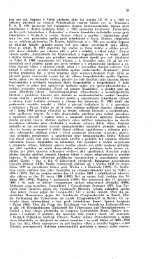Create successful ePaper yourself
Turn your PDF publications into a flip-book with our unique Google optimized e-Paper software.
<strong>Gynekol</strong> 4-<strong>08</strong> 25.7.20<strong>08</strong> 9:47 Str. 241<br />
Rizikové faktory uroinfekcí po gynekologických<br />
operacích<br />
Risk Factors for Postsurgical Uroinfection in Gynecology<br />
Čadková I. 1 , Doudová L. 2 , Michálek J. 3 , Huvar I. 1<br />
1 <strong>Gynekol</strong>ogicko-porodnické oddělení Nemocnice Milosrdných bratří, Brno, primář MUDr. I. Huvar, CSc.<br />
2 Katedra ekonometrie, Fakulta ekonomiky a managementu, Univerzita obrany, Brno,<br />
vedoucí prof. RNDr. Z. Zemánek, CSc.<br />
3 Ústav matematiky, Fakulta strojního inženýrství, VUT Brno, ředitel prof. RNDr. J. Šlapal, CSc.<br />
ABSTRACT<br />
Objective: This study eims to evaluate risk factors for postsurgical uroinfection (UTI) in gynecology.<br />
Design: Clinical retrospective trial.<br />
Setting: Obstetrics and Gynecology Department, Merciful Brothers Hospital, Brno.<br />
Materials and Methods: All of 290 women who underwent hysterectomy and/or anterior vaginal repair<br />
(with or without anti-incontinence operation) in our hospital during the year 2005 were studied. The<br />
following data were noted: age, weight, anamnestic UTI, diabetes, other serious morbidity, moving<br />
disorders, estrogene deficiency, the type of surgery, the type of catheter and the duration of its indweling,<br />
intra/postoperative complications, urologic symptoms and urine analysis including bacteriology on the<br />
6th postoperative day. There were excluded cases with antibiotic therapy (due to non-urological<br />
indications) from the study. The risk factors were assessed on the rest of 262 women, in two subgroups<br />
according to the catheter type (Foley/minicatheter), as there were remarcable differences in the<br />
indwelling time and other characteristics. „Mini-catheter“ (a thin transurethral catheter) enables<br />
spontaneous voiding as well as measuring the postmiction residuum. It was used in case of anterior<br />
vaginal repair or Burch operation and extracted as soon as the voiding function had been restored,<br />
mostly on the 2nd-3rd day. The Foley was used in the others, mostly for one day. The unidimensional<br />
(Fisher and Mann-Whitney test) and multidimensional (logit model, Walds statistic) analyses were<br />
performed. The influence of the type of catheter itself was analysed within an indwelling time period<br />
(20-32 hours) in which women of both subgroups were present.<br />
Results: The Foley group (115 women, indwelling time 16-32 hours) had 3,5% UTI, none of studied<br />
factors was estimated as significant. In the mini-catheter group (147 women, catheterisation for 20-234<br />
hours) was 35,4% UTI, with two risk factors: the time of catheterisation (p=0.000029) and complications<br />
(p=0.021515). The statistic model we have used (logit analysis) predicts UTI with sensitivity 61,5 and<br />
specificity 89,5. There was no difference in the risk of UTI between the two types of used catheters in case<br />
of equal time of their insertion.<br />
Conclusion: Postsurgical UTI was connected significantly with the duration of catheterisation and<br />
intra/postoperative complications. In case of short time catheterisation (up to 32 hours), however, the<br />
percentage of UTI was low and no risk factor was assessed as significant.<br />
Key words: UTI (urinary tract infection), CAUTI (catether associated UTI), risk factors, hysterectomy,<br />
vaginal prolapse.<br />
SOUHRN<br />
Cíl studie: Stanovení faktorů podílejících se na vzniku uroinfektu (UI) po gynekologických operacích<br />
a určení jejich významnosti.<br />
Typ studie: Klinická retrospektivní studie.<br />
Název a sídlo pracoviště: <strong>Gynekol</strong>ogicko-porodnické oddělení Nemocnice Milosrdných bratří v Brně.<br />
Metodika: Vyhodnocení 290 žen, které v období od 1.1. do 31.12. 2005 podstoupily na našem oddělení hysterektomii<br />
a/nebo rekonstrukci přední poševní stěny, s antiinkontinenční operací nebo bez ní. Sledované<br />
faktory: věk, hmotnost, uroinfekty v anamnéze, diabetes, jiná závažná komorbidita, omezení hybnosti,<br />
estrogenní deficit, typ (Foley/minikatetr) a délka doby zavedení katetru, komplikace, urologické symptomy<br />
a výsledky laboratorního i kultivačního vyšetření moče 6. pooperační den. Ze studie bylo vyloučeno<br />
28 pacientek s nasazením antibiotik pro ne-urologické důvody. Statistické vyhodnocení bylo provedeno<br />
na zbylých 262 případech, a to v podskupinách podle typu katetru (Foley/minikatetr), které se lišily<br />
významně v délce jeho zavedení i v jiných charakteristikách. Minikatetr (tenký transuretrální katetr)<br />
umožňuje spontánní mikci i změření postmikčního rezidua. Užívá se po rekonstrukcích přední poševní<br />
stěny nebo po operaci podle Burche do doby dostatečně obnovené mikční funkce, většinou do 2. až 3. dne.<br />
Čes. Gynek.<br />
20<strong>08</strong>, 73, č. 4<br />
s. 241-247<br />
241



